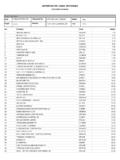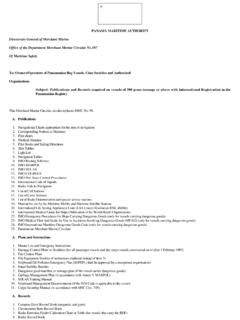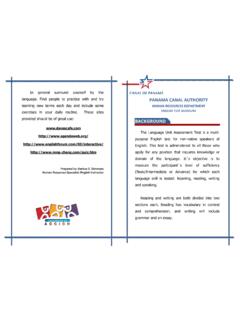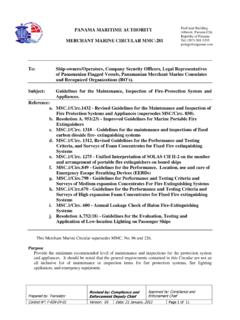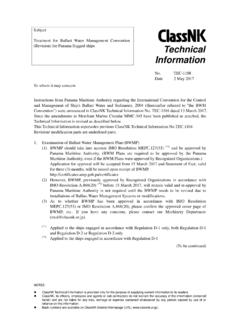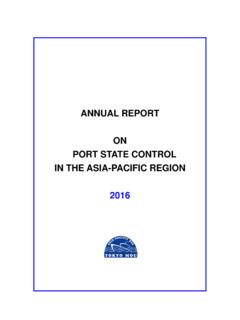Transcription of The Spanish is the official version of this document. …
1 The Spanish is the official version of this document. The English translation is intended solely for the purpose of facilitating an overall understanding of the content of the original version for the benefit of those persons who do not speak the INDEX REGULATION ON NAVIGATION IN panama CANAL WATERS Articles Pages CHAPTER I general PROVISIONS 1 27 7 15 Section One general provisions and definitions 1 8 7 13 Section Two Risk prevention and control 9 11 13 Section Three Scheduling, booking, order, and preference in transit 12 25 13 15 Section Four Requirements and prohibitions 26 27 15 CHAPTER II RADIO COMMUNICATIONS 28 34 15 16 CHAPTER III VESSEL ARRIVAL AND ANCHORAGE 35 49 16 17 Section One Communication and coordination 35 36 16 Section Two Anchorage and inspection 37 46 16 17 Section Three Precautionary measures and attachment of vessels 47 49 17 CHAPTER IV general AND SPECIFIC PROVISIONS REGARDING VESSELS 50 89 17 23 Section One Dangerous vessels 50 51 17 Section Two Size, draft.
2 And trim limitations of vessels 52 56 18 Section Three Boarding facility requirements 57 58 18 Section Four Construction, number, and locations of chocks and bitts 59 60 18 Section Five Navigation bridge requirements 61 64 19 Section Six Maneuvering characteristics 65 19 Section Seven Signalsystem 66 19 Section Eight Engine orders to be recorded 67 20 Section Nine Provision of meals 68 20 Section Ten Sanitary facilities 69 20 Section Eleven Disabling of engines 70 20 Section Twelve Emission of sparks, smoke, or noxious gases 71 20 Section Thirteen Deck load cargo 72 73 21 Section Fourteen Deck loaded containers on ships not purpose built for container carriage 74 76 21 Section Fifteen Prohibitions on fishing, placing of nets, and other obstructions 77 79 21 22 Section Sixteen Non self propelled vessels 80 22 Section Seventeen Small craft, yachts, and other handlines 81 86 223 Section Eighteen Navigation in Culebra Cut (Gaillard) 87 22 Section Nineteen Gear for transiting 88 23 Section Twenty Flags and pennants 89 23 CHAPTER V PILOTAGE 90 101 24 Section One Compulsory pilotage 90 98 23 24 Section Two Exemptions from compulsory pilotage in the ports 99 101 24 CHAPTER VI REQUIREMENTS CONCERNING THE CREW 102 106 24 25 Section One Vessels to be fully manned 102 104 25 Section Two Master and officers 105 25 Section Three Persons not allowed on bridge 106 25 CHAPTER VII ENTERING AND PASSING THROUGH THE LOCKS 107 25 CHAPTER VIII PREVENTION OF COLLISIONS 108 111 25 26 CHAPTER IX DANGEROUS CARGO 112 141 26 29 Section One general provisions, classification, and inspection 112 116 26 Section Two Dangerous cargo in bulk 117 126 26 27 Section Three Dangerous packaged goods 127 141 27 29 Section Four Vessel Contingency Plans for Oil Spills in panama Canal Waters 141A 141 C 29 CHAPTER X OFFENSES, SANCTIONS.
3 AND SANCTIONING PROCEEDINGS 142 185 30 37 Section One general provisions 142 147 30 Section Two Offenses 148 150 30 32 Section Three Sanctions 151 154 33 Section Four Opening of the proceedings 155 160 33 34 Section Five Investigation 161 168 34 35 Section Six Conclusion of the proceedings 169 172 35 36 Section Seven Summary proceedings 173 175 36 Section Eight Administrative remedies 176 181 36 37 Section Nine Notices 182 185 374 ANNEX Articles Pages CHAPTER I general PROVISIONS 39 40 Section One general provisions and definitions 8 39 Section Three Scheduling, booking, order, and preference in transit 16, 17, 23, 24 39 40 CHAPTER II RADIO COMMUNICATIONS 29, 30 40 43 CHAPTER III VESSEL ARRIVAL AND ANCHORAGE 44 51 Section One Communication and coordination 36 44 45 Section Two Anchorage and inspection 37, 38, 41, 43, 45 45 51 Section Three Precautionary measures and attachment of vessels 51 CHAPTER IV general AND SPECIFIC PROVISIONS REGARDING VESSELS 52 80 Section One Dangerous vessels 50 52 Section Two Size, draft, and trim limitations of vessels 52, 53, 55, 56 52 58 Section Three Boarding facilities 57 58 61 Section Four Construction, number and location of chocks and bitts 59 62 65 Section Five Navigation bridge requirements 61, 64 66 72 Section Six Maneuvering characteristic 65 73 74 Section Eight Engine orders to be recorded 67 74 Section Thirteen Deck load cargo 72 75 76 Section Sixteen Non self propelled vessels 80 77 78 Section Seventeen Small craft, yachts, and other handlines 82 78 79 Section Nineteen Gear for transiting 88 79 Section Twenty Flags and pennants 89 79 80 CHAPTER V PILOTAGE 80 81 Section One Compulsory pilotage 90.
4 94 80 Section Two Exemptions from compulsory pilotage in the ports 99 80 81 CHAPTER VI REQUIREMENTS CONCERNING THE CREW 81 825 Section One Vessels to be fully manned 103 81 82 Section Two Master and officers 105 82 CHAPTER VII ENTERING AND PASSING THROUGH THE LOCKS 107 82 85 CHAPTER VIII PREVENTION OF COLLISIONS 108 86 108 Section One general provisions 86 87 Rule 1 Application 86 Rule 2 general Definitions 86 87 Section Two Steering and sailing rules Conduct of Vessels in any Condition of Visibility 87 94 Rule 3 Application 87 Rule 4 Lookout 87 Rule 5 Safe Speed 87 89 Rule 6 Risk of Collision 89 Rule 7 Maneuvers to Avoid Collision 89 90 Rule 8 Narrow Channels 90 Rule 9 Conduct of Vessels in Sight of One Another Application 90 Rule 10 Sailing Vessels 91 Rule 11 Overtaking 91 Rule 12 Head on Situation 92 Rule 13 Crossing Situation 92 Rule 14 Maneuvering by Give Way Vessel 92 Rule 15 Maneuvering by Stand on Vessel 92 93 Rule 16 Responsibilities between types of vessels 93 Rule 17 Conduct of Vessels in Restricted Visibility 93 94 Section Three Lights and shapes 94 101 Rule 18 Application 94 Rule 19 Definitions 95 Rule 20 Visibility of Lights 95 96 Rule 21 Power driven vessels under way 96 97 Rule 22 Vessels Towing and Pushing 97 98 Rule 23 Sailing Vessels Under Way and Vessels Under Oars 98 99 Rule 24 Fishing Vessels 99 Rule 25 Vessels Not Under Command or Restricted in their Ability to Maneuver 99 100 Rule 26 Pilot Vessels 100 Rule 27 Anchored Vessels and Vessels Aground 101 Rule 28 Seaplanes 101 Section Four Sound and light signals 102 1066 Rule 29 Definitions 102 Rule 30 Equipment for Sound Signals 102 Rule 31 Maneuvering and Warning Signals 102 103 Rule 32 Sound Signals in Restricted Visibility 103 104 Rule 33 Signals to Attract Attention 104 105 Rule 34 Distress Signals 105 106 Section Five Miscellaneous 106 108 Rule 35 Diving Operations 106 Rule 36 Regulations on Small Crafts Not Transiting the Canal 106 107 Rule
5 37 Lights Marking of Pipeline Laid in Navigable Waters 107 Rule 38 Lights on Barges at Bank or Dock 107 108 CHAPTER IX DANGEROUS CARGO 108 114 Section One general provisions, classification, and inspection 114, 115 108 110 Section Two Dangerous cargo in bulk 120, 121, 126 110 112 Section Three Dangerous packaged goods 128, 130, 132, 134, 141 112 113 Section Four Vessel Contingency Plans for Oil Spills in panama Canal Waters 141A 141 C 113 1147 AGREEMENT No. 13 (of June 3, 1999) Whereby the Regulation on Navigation in panama Canal Waters is approved THE BOARD OF DIRECTORS OF THE panama CANAL AUTHORITY WHEREAS: In accordance with article e of the panama Canal Authority Organic Law, the Board of Directors is responsible for approving the regulations regarding navigation, marine traffic control, pilotage, and matters concerning navigation in the Canal. The draft regulations on the foregoing subjects have been submitted by the Administrator, in exercise of the authority granted to him by article of the above mentioned law.
6 AGREES: The following regulations on navigation in Canal waters are adopted: REGULATIONS ON NAVIGATION IN panama CANAL WATERS Chapter I general Provisions Section One general provisions and definitions Article 1: All activities related to navigation of vessels in waters that are within the Canal Operation Compatibility Area, as described in the Annex of the panama Canal Authority Organic Law, shall be controlled by this regulation. The Administrator, panama Canal Authority, shall apply this regulation through the administrative units designated for such purpose. Article 2: Vessels shall keep aboard a copy of the regulations regarding navigation in Canal Article 3: 1 The Canal Authority shall establish the requirements and conditions of stability, list, trim, draft, cargo, hull, machinery, and of any other nature, including boarding and sanitation facilities, to allow transit of the vessel and to ensure its safety, as well as that of Canal personnel and structures.
7 The Authority may deny a vessel s transit if any of the established requirements is not met. However, in those cases in which the Authority determines that the ship may transit safely using additional resources provided by the Authority, it may authorize the transit, provided the vessel assumes and pays the corresponding additional charges. Article 4: Any vessel that fails to meet the requirements for a normal transit, may only transit with the Authority s express authorization, provided the master of the vessel signs a document undertaking to release from all liability and to indemnify the panama Canal Authority and the Republic of panama for any damages sustained. The vessel is also liable for any damages sustained by third parties, arising as a result of the above. Failure to comply with the above requirement shall not relieve the vessel, her owners, or any other person having an interest in her, from liability incurred as a result of any damages sustained. Article : 2 The Authority may deny the departure of any vessel which has caused damages to the Canal, its personnel, equipment, property or facilities, or which violates any Canal navigation safety rule, until such time as she has posted a suitable payment warranty, to the Canal Administration s satisfaction.
8 To ensure enforcement of this rule, the Authority may require the assistance of the Public Force. The cost of this assistance shall be charged to the vessel, and shall be included in the warranty. Article 5: Embarking or disembarking a vessel in Canal waters without the authorization of the Authority, is a risk to navigation safety. These acts shall be punished in accordance with article 127 of the Organic Law, and the Authority shall not be liable for any resulting personal injuries, or damages to vessels or property. Article 6: Failure to comply with any of the requirements or conditions established by this regulation, shall be reason to deny any claims for delays in navigation. Article 7: Vessels are subject to inspection, to ensure compliance with and application of this regulation and the regulations pertaining to Safety, Admeasurement and Sanitation and Prevention of Communicable Diseases. Article 8: The words, expressions, and abbreviations used in this Regulation shall have the following meaning and scope: panama Canal Waters.
9 Refers to all waters within the Canal Operation Compatibility Area. 1 Amended by article one of Agreement 51 of November 8, 2001. 2 Added by Agreement No. 37 of July 14, Canal Operation Compatibility Area. The geographic area described in itema of the Annex, including its lands and waters, where only activities compatible with the operation of the Canal may be carried out. Vessel. Every description of water craft, including non displacement craft and seaplanes, used or capable of being used as a means of transportation on water. Power driven vessel. Any vessel propelled by machinery. Sailing Vessel. Any vessel under sail, provided that propelling machinery, if fitted, is not being used. Vessel engaged in fishing. Any vessel fishing withnets, lines, trawls or other fishing apparatus, which restrict maneuverability, but does not include a vessel fishing with trolling lines or other fishing apparatus which do not restrict maneuverability. Seaplane. Any aircraft designed to maneuver on the water.
10 Vessel not under command. A vessel which, through some exceptional circumstance, is unable to maneuver as required, and is unable to keep out of the way of another vessel. Vessel restricted in her ability to maneuver. A vessel which from the nature of her work is restricted in her ability to maneuver as required, and is unable to keep out of the way of another vessel. (See itemb of the Annex.) Under way. Applies to a vessel that is not at anchor, or made fast to the shore, or aground. Length and breadth. The length overall and greatest breadth of a vessel. Vessels in sight of one another. Only when one can be observed visually from the other. Restricted Visibility. Any condition in which visibility is restricted by fog, mist, smoke, heavy rainstorms, or any other similar causes. Motorboat. A power driven vessel 20 meters (65 feet) in length or less. Pilot Vessel. A vessel engaged in pilotage duty. Composite Unit. A pushing vessel that is rigidly connected by mechanical means to a vessel being pushed ahead, so that they react to sea and swell as one vessel.



